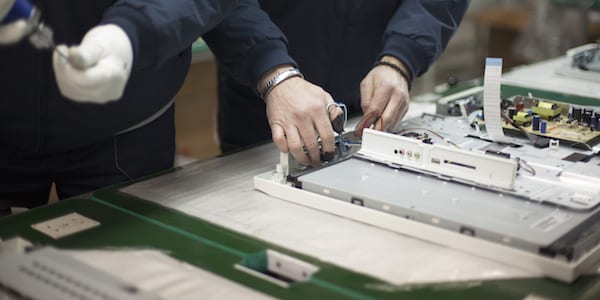
Every square meter counts
CASE STUDY – When it had to develop a production process for a new product from scratch, this Dutch company leveraged lean tools and practices. And the results were impressive.
Words: Frank van Velzen, Trainer and Senior Advisor, Lean Management Instituut
Introducing a new product into your production schedule can be a daunting undertaking, especially when the product is complex and there are neither a process nor a line in place that are adequate to its manufacture. This is the situation Royal Vezet, a 108-year-old family-owned food company in the Netherlands, found itself recently. Its client, supermarket chain Albert Heijn, had decided to introduce Culii, a make-it-yourself meal box with one starter and one main course that feed two people and can be prepared in as little as 10 minutes.
Due to the high number of ingredients that go into the box, Culii was by far the most complex product Vezet ever had to assemble. The company decided to produce it in its small factory in Purmerend, just north of Amsterdam (Vezet has a total of seven plants in the Netherlands, with a total of 72 product lines), because of its equipment and the expertise of the team there. Still, the challenge was great: with Culii, the expected production volume of the Purmerend facility would go up 250% and the goal was to achieve that volume without any extra investment (be it in machines or more space).
Faced with the task of having to design and stand up a whole new process – one that would be lean from the start and that they could rely on for the coming years – Vezet asked Lean Management Instituut for help (they had been working together for two and half years already).
From the start, the idea was to assemble the meal boxes on one line, with three sub-assembly lines feeding it. Each Culii box comes with a starter and a main course, of which there are four types respectively that can be mixed and matched. Additionally, the ingredients going into each box were many and of varying degrees of assembling complexity. Such variations could easily lead to long change-over times and make it hard to work with small batches and with the little space that was available.
The team’s first step was, therefore, to categorize all ingredients by complexity. They came up with three levels: easy (like a pre-packaged cheese bar that simply has to be put into the Culii box), medium (like any product that has to be weighed), and hard (products that have to be cooked).
Once they understood the complexity, they looked for ways to reduce it and to even out the work across the line, thus making it more predictable. What they wanted was the same complexity, in the same place, all the time. To optimize the process, they used the ECRS framework – Eliminate-Combine-Rearrange-Simplify – and then began to define the amounts of resources they would need (in terms of people, machines, and square meters). A takt-time for the overall production process was identified, and it was determined that a Culii box would have to come out of the line every 8.4 seconds, filling a pallet every 30 minutes.
The team’s goal was to start making the best possible use of every single square meter in the facility – which, luckily, is lean’s forte. For that to happen, the biggest change that was implemented was a move from batch-and-queue to small batches worked on in flow. Prior to this lean experiment, production happened in three steps that took place over three days, which, of course, led to a lot of work-in-progress and big inventories. With the introduction of Culii, this was no longer an option, because the team needed the space to produce the high volumes requested by the customer.
With flow as an end-goal, the team moved to small batches and started to produce on the same day, several times a day. The process produced the Culii boxes and got them ready for delivery, organizing the work in 45-minute time blocks (of which they were eight each day), with small amounts of raw materials and ingredients fed to the line each time. During those 45 minutes, each area involved in the process did its part (for instance, cooking a chicken) and fed its output to the main line, for assembly. What made this work flawlessly was the introduction of Job Instructions sheets – which allowed for standardization – and the reorganization of tools and raw materials to ensure they’d be available to workers whenever they needed them, in the right amount and at the right moment.
To develop the new system, the work was essentially broken down and analyzed in depth (with the book Kaizen Express offering great help with its detailed instructions). The Bill of Materials was studied to understand what each order entailed in terms of square meters, raw materials and ingredients used, and how many people were needed to process it. This way, every shift learned exactly what had to be in place for the output to be reached and each area what they had to contribute to the production line and what they needed to make that happen. Having people work together, with the support of team and shift leaders as well as business unit managers, is what ultimately made a difference. The factory’s layout was also changed, using spaghetti diagrams to understand how workers moved across the facility and minimize their movements.
All this work was done in preparation for a test run that would assess the capabilities of the system, which would deploy five people in total, against the three complexity scenarios. The team wanted to understand whether they could deliver orders with the takt time they set and how many people they would need to do it. The plan for the test run was detailed but, as usual, reality and theory are often very different. So, after the test run, and the others that followed, adjustments were made based on the observations and learnings of the team. This is the kind of iterative approach that makes Lean Thinking such a powerful framework for change.
When the pilot project kicked off, Vezet was supplying Culii to just a few Albert Heijn supermarkets, producing 2,500 boxes each day. Two weeks in, however, the client announced that they would need 20,000 boxes a day throughout Easter week.
The team thought it wouldn’t be possible but was eventually able to deliver the volumes requested by the customer every day – both during the peak Easter period and on regular days. In fact, this was Vezet’s first product introduction without any failures. This demonstrates the stability of the process the team designed together with Lean Management Instituut. The KPI that, perhaps more than any other, proves the solidity of the new process is the number of items every worker makes in one hour: it was 15 at the beginning of the project and it is now 36 (it’s expected to reach 40 by the end of the year).
The most important result, however, was that Vezet is now fully leveraging the knowledge that exists in its ranks. The learnings the team was able to generate are now informing every new product introduction at the company, which makes them better prepared for any situation they might face in the future.
THE AUTHOR

Read more


COLUMN - In political terms, is lean management more in line with conservative principles or progressive ideas? Michael Ballé reflects on a tough question.


CASE STUDY – UK law firm Weightmans has transformed its new legal case intake process using the Lean Transformation Framework, revolutionizing both operations and people development.


INTERVIEW – This cardiac laboratory in Singapore was targeting one improvement and ended up with something different, but equally impactful for its patient flow.


ARTICLE - We always talk about going to the gemba, but we often don't understand what that entails and what changes it can bring to our companies. In this article, we hear about the experience of Thales.
Read more


NOTES FROM THE VIRTUAL GEMBA – Despite a 40% drop in sales and the looming prospect of having to furlough part of its staff, this French company is finding in lean manufacturing an ally to fight the current crisis.


FEATURE – The restaurant business has always been tough, but Covid-19 is now presenting it with new challenges. The author shares a few lean practices that can help restaurants develop competitiveness.


FEATURE – The future has never looked more uncertain for restaurants and cafes. The authors share a set of practical lean tips that can guide these organizations navigate the storm.


FEATURE – The problems agricultural businesses encounter every day can be solved using simple concepts of lean maintenance, resulting in considerable gains.

